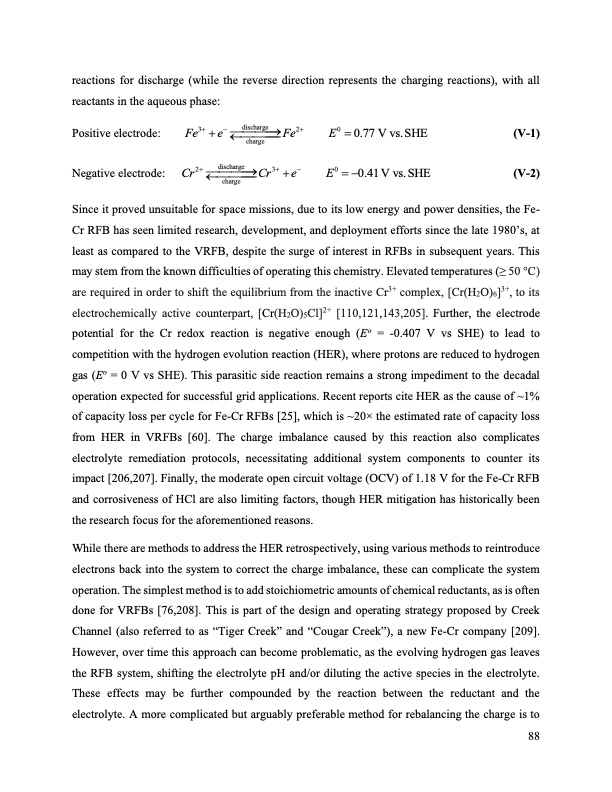
PDF Publication Title:
Text from PDF Page: 088
reactions for discharge (while the reverse direction represents the charging reactions), with all reactants in the aqueous phase: Positive electrode: Negativeelectrode: Fe3+ + e- discharge Fe2+ 3⁄43⁄43⁄43⁄4® E0 = 0.77 V vs. SHE E0 =-0.41Vvs.SHE (V-1) (V-2) Cr2+ discharge Cr3+ +e- 3⁄43⁄43⁄43⁄4® ¬3⁄43⁄43⁄4 ¬3⁄43⁄43⁄4 charge charge Since it proved unsuitable for space missions, due to its low energy and power densities, the Fe- Cr RFB has seen limited research, development, and deployment efforts since the late 1980’s, at least as compared to the VRFB, despite the surge of interest in RFBs in subsequent years. This may stem from the known difficulties of operating this chemistry. Elevated temperatures (≥ 50 °C) are required in order to shift the equilibrium from the inactive Cr3+ complex, [Cr(H2O)6]3+, to its electrochemically active counterpart, [Cr(H2O)5Cl]2+ [110,121,143,205]. Further, the electrode potential for the Cr redox reaction is negative enough (Eo = -0.407 V vs SHE) to lead to competition with the hydrogen evolution reaction (HER), where protons are reduced to hydrogen gas (Eo = 0 V vs SHE). This parasitic side reaction remains a strong impediment to the decadal operation expected for successful grid applications. Recent reports cite HER as the cause of ~1% of capacity loss per cycle for Fe-Cr RFBs [25], which is ~20× the estimated rate of capacity loss from HER in VRFBs [60]. The charge imbalance caused by this reaction also complicates electrolyte remediation protocols, necessitating additional system components to counter its impact [206,207]. Finally, the moderate open circuit voltage (OCV) of 1.18 V for the Fe-Cr RFB and corrosiveness of HCl are also limiting factors, though HER mitigation has historically been the research focus for the aforementioned reasons. While there are methods to address the HER retrospectively, using various methods to reintroduce electrons back into the system to correct the charge imbalance, these can complicate the system operation. The simplest method is to add stoichiometric amounts of chemical reductants, as is often done for VRFBs [76,208]. This is part of the design and operating strategy proposed by Creek Channel (also referred to as “Tiger Creek” and “Cougar Creek”), a new Fe-Cr company [209]. However, over time this approach can become problematic, as the evolving hydrogen gas leaves the RFB system, shifting the electrolyte pH and/or diluting the active species in the electrolyte. These effects may be further compounded by the reaction between the reductant and the electrolyte. A more complicated but arguably preferable method for rebalancing the charge is to 88PDF Image | Bringing Redox Flow Batteries to the Grid

PDF Search Title:
Bringing Redox Flow Batteries to the GridOriginal File Name Searched:
Rodby-krodby-phd-chemE-2022-thesis.pdfDIY PDF Search: Google It | Yahoo | Bing
Salgenx Redox Flow Battery Technology: Salt water flow battery technology with low cost and great energy density that can be used for power storage and thermal storage. Let us de-risk your production using our license. Our aqueous flow battery is less cost than Tesla Megapack and available faster. Redox flow battery. No membrane needed like with Vanadium, or Bromine. Salgenx flow battery
| CONTACT TEL: 608-238-6001 Email: greg@salgenx.com | RSS | AMP |